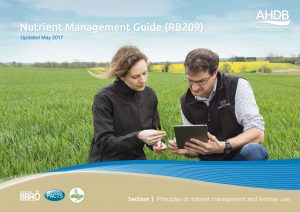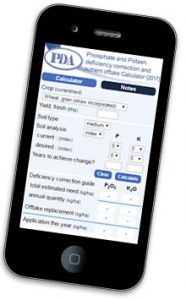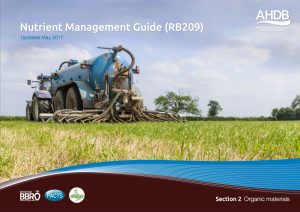Download pdf: AHDB Nutrient Management Guide (RB209) (1.34M)
pdf 1.34M
AHDB Nutrient Management Guide (RB209)
June 2017
AHDB have just launched their new Nutrient Management Guide (RB209). It is a revision of the Defra Fertiliser Manual (RB209) and it can be viewed or downloaded to your computer from their website www.ahdb.org.uk/rb209. Also, there is an App for mobile devices. Hard copies can be requested by e mail to cereals.publications@ahdb.org.uk. It is supplied free of charge to farmers, students and advisers.
AHDB took over responsibility for RB209 (issued in 2010) from Defra and the revising process has been undertaken over the last 2 years. Fresh trials data and a wider range of crops and organic materials have been included in this update. It is planned that updating will happen more frequently in future and it will become more digital and interactive.
 The new format comprises 7 separate sections:-
The new format comprises 7 separate sections:-
- Principles of Nutrient Management
- Organic Materials
- Grass & Forage Crops
- Arable Crops
- Potatoes
- Veg & Bulbs
- Fruit Vines & Hops
It is expected that everyone will want to use Section 1 (Principles) and Section 2 (Organic Materials) along with those of the other sections that are relevant to their farm/advisory business.
Main changes highlighted
NB. Nitrogen recommendations have changed for some arable crops and for grass but they are not covered in this article.
There are 4 main areas of change concerning P, K, S and Mg:-
- Speed of building up low soil indices
- Crop Offtake values
- Nutrient content of Organic Materials
- Sulphur recommendations
Speed of building up low soil indices for P and K
The Principles Section now recognises that the rates of building up low soil indices to reach target index (P2, K2-) may be too slow. Current build values take 10-15 years to build, and this is far too long for the field yields to be hindered by their low indices. It discusses this issue and quotes alternative build values to achieve target index in only 5-10 years, which is very helpful. However, the specific tables in the grass and crop sections do still use the same slow build rates as previously.
PDA has always believed that the farmer/adviser should decide the number of years to achieve target index, based on minimising the years of reduced yields. The PK Calculator on our website allows the number of years to be entered to get the annual recommendations.
This gives flexibility in building indices on any farm. It also recognises that different soil types require different amounts of Phosphate and Potash to reach target index, so it gives a more specific and accurate recommendation too.
We believe that only the cost of the maintenance application (= nutrient offtake) should be charged to the individual crop budget, and the extra cost required to build the indices should be considered more of an overhead cost, to get the soil fit to grow high yielding crops – much as drainage and lime expenditure are perceived.
Crop Offtake Values

The crop offtake values for Phosphate and Potash are now shown for crops in their relevant Section, and not in one table as previously.
The changes are based on a dataset including many more recent sample analyses, since the old RB209 was produced. Some of the forage crop values have been changed reflecting differences in nutrient removal with grazed versus harvested crops.
Some additional crops, such as wholecrop cereals, haylage, and miscanthus, have been included.
The revised PDA leaflet “Nutrients in Crop Material” is a useful alternative reference. It also includes some guidance on Magnesium offtakes, but please note they are based on limited data.
The PK Calculator 2017 can be accessed on our website www.pda.org.uk and can be downloaded as an App to handheld devices.
Organic Materials
This Section was previously called Organic Manures, but it now includes more information on some organic materials which are not animal manures, such as Digestate, Composts and some commercial wastes.
The “typical” nutrient contents for P, K, S and Mg have been updated by including data from more recent analyses. It is noticeable that Phosphate values in Biosolids have been reduced, and so has the Potash content in slurries. However the Potash content in Cattle FYM has risen.
 There is a new table to show the crop availability of Sulphur from organic materials which is the result of recent research work. The table is based on the season of application, and the type of organic material. The type of material reflects how quickly it releases sulphur to become available to the crop. The season is one of the factors in leaching potential.
There is a new table to show the crop availability of Sulphur from organic materials which is the result of recent research work. The table is based on the season of application, and the type of organic material. The type of material reflects how quickly it releases sulphur to become available to the crop. The season is one of the factors in leaching potential.
Although the nutrient contents quoted are reasonable default values, the Guide emphasises the preference for organic materials to be analysed by a laboratory, to provide accurate values for the specific material on the farm, and it should be done each year. The “typical” figures quoted are derived from a wide range of analysis results, especially for animal manures, and the reality will vary considerably from farm to farm according to bedding materials, feeding regime etc. As a result, the previous essential guidance of a protocol for taking the samples is retained, and references to video clips, demonstrating the sampling methods, have been added. The need to take a “truly representative” sample is paramount, otherwise the laboratory analysis is pointless, and “typical” values should be used instead.
The revised PDA leaflet “Organic Materials” is a useful alternative reference.
Sulphur Recommendations
In the Principles Section, the Sulphur information has been expanded and updated to reflect new data that is available. The deposition of Sulphur from the atmosphere has continued to decline rapidly, to the extent that far more situations now require applications of fertilisers or organic materials, to support crop growth effectively. There is now a risk table to help assess the need for Sulphur, based on soil type and winter rainfall, reflecting its potential to be leached over winter.
Grass for silage cuts, and winter oilseed rape are identified as being particularly vulnerable to Sulphur deficiency, as before, and almost all situations will benefit from annual applications. Cereals, peas, brassica vegetables and potatoes (new recommendation) are also at risk and should be assessed carefully.
Diagnosis of Sulphur deficiency in the plant is useful for some crops where adequate Sulphur data exists, such as cereals, oilseed rape and grass. There is no reference to the use of soil analysis because Sulphur is so mobile in the soil. However, Sulphur analyses coupled with the Soil Mineral Nitrogen analyses in the early Spring may be useful.
On livestock farms, fields which regularly receive organic manures, will be less at risk of deficiency, but grass for 2nd (and later) cuts is still likely to benefit from applied Sulphur. This is because the very short period for regrowth may not give time for enough soil Sulphur to become crop available. Sulphur is important to support the grass growth as well as the protein value of the silage.
Finally
This article has highlighted the main P, K, Mg and S changes in principle, however, there are many specific details that have changed, and these should be checked carefully when making specific nutrient recommendations.

